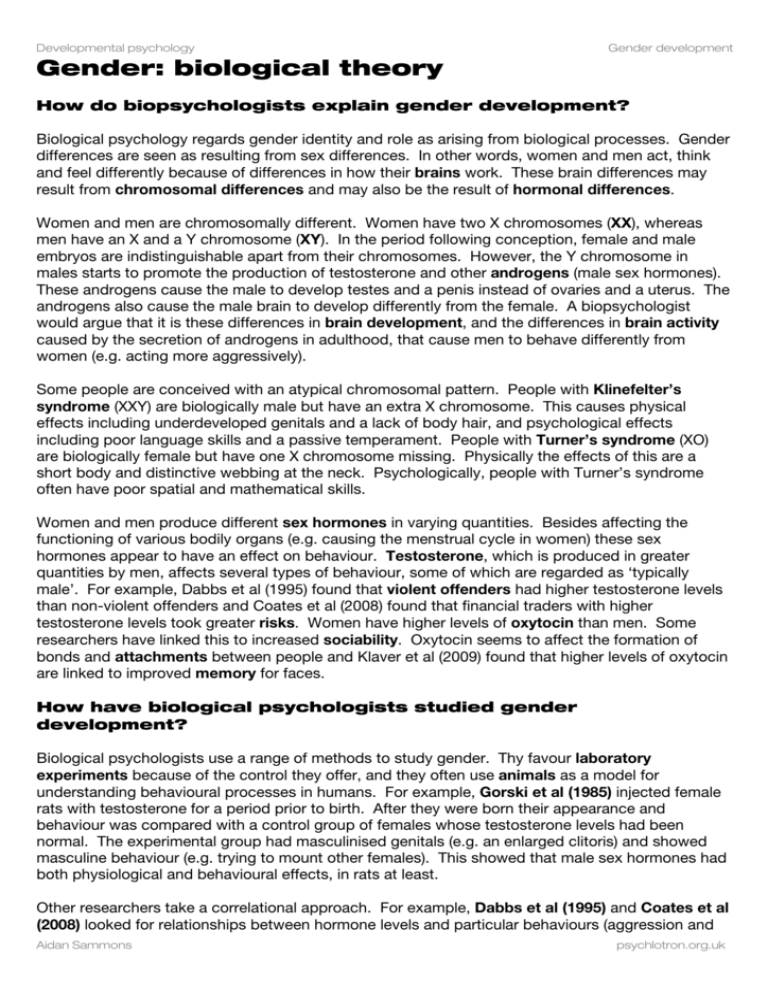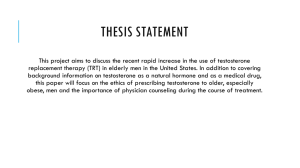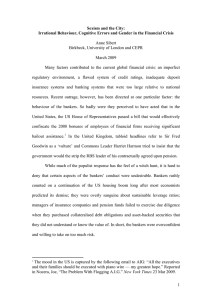GD060- Gender - biological theory
advertisement

Developmental psychology Gender development Gender: biological theory How do biopsychologists explain gender development? Biological psychology regards gender identity and role as arising from biological processes. Gender differences are seen as resulting from sex differences. In other words, women and men act, think and feel differently because of differences in how their brains work. These brain differences may result from chromosomal differences and may also be the result of hormonal differences. Women and men are chromosomally different. Women have two X chromosomes (XX), whereas men have an X and a Y chromosome (XY). In the period following conception, female and male embryos are indistinguishable apart from their chromosomes. However, the Y chromosome in males starts to promote the production of testosterone and other androgens (male sex hormones). These androgens cause the male to develop testes and a penis instead of ovaries and a uterus. The androgens also cause the male brain to develop differently from the female. A biopsychologist would argue that it is these differences in brain development, and the differences in brain activity caused by the secretion of androgens in adulthood, that cause men to behave differently from women (e.g. acting more aggressively). Some people are conceived with an atypical chromosomal pattern. People with Klinefelter’s syndrome (XXY) are biologically male but have an extra X chromosome. This causes physical effects including underdeveloped genitals and a lack of body hair, and psychological effects including poor language skills and a passive temperament. People with Turner’s syndrome (XO) are biologically female but have one X chromosome missing. Physically the effects of this are a short body and distinctive webbing at the neck. Psychologically, people with Turner’s syndrome often have poor spatial and mathematical skills. Women and men produce different sex hormones in varying quantities. Besides affecting the functioning of various bodily organs (e.g. causing the menstrual cycle in women) these sex hormones appear to have an effect on behaviour. Testosterone, which is produced in greater quantities by men, affects several types of behaviour, some of which are regarded as ‘typically male’. For example, Dabbs et al (1995) found that violent offenders had higher testosterone levels than non-violent offenders and Coates et al (2008) found that financial traders with higher testosterone levels took greater risks. Women have higher levels of oxytocin than men. Some researchers have linked this to increased sociability. Oxytocin seems to affect the formation of bonds and attachments between people and Klaver et al (2009) found that higher levels of oxytocin are linked to improved memory for faces. How have biological psychologists studied gender development? Biological psychologists use a range of methods to study gender. Thy favour laboratory experiments because of the control they offer, and they often use animals as a model for understanding behavioural processes in humans. For example, Gorski et al (1985) injected female rats with testosterone for a period prior to birth. After they were born their appearance and behaviour was compared with a control group of females whose testosterone levels had been normal. The experimental group had masculinised genitals (e.g. an enlarged clitoris) and showed masculine behaviour (e.g. trying to mount other females). This showed that male sex hormones had both physiological and behavioural effects, in rats at least. Other researchers take a correlational approach. For example, Dabbs et al (1995) and Coates et al (2008) looked for relationships between hormone levels and particular behaviours (aggression and Aidan Sammons psychlotron.org.uk Developmental psychology Gender development risk taking respectively). This was done because it would have been both impractical and unethical to experimentally manipulate hormone levels in humans in order to assess their behavioural effects. Evaluation of the biological theory of gender It is clear from a range of studies involving humans and other animals that chromosomal and hormonal differences between males and females affect a range of masculine and feminine behaviours, which supports the biological view. However, much of this research is correlational. Consequently, whist it indicates a relationship between, for example, testosterone levels and risk taking, it does not indicate the direction of causality. Whilst higher testosterone might cause people to make riskier decisions, it might also be that the process of taking risks causes testosterone levels to rise. However, where the research was carried out with non-human animals there is a need for caution in assuming that the results apply to humans. This does not mean that you can’t generalise from one to the other, but at the same time, each species has its own unique evolutionary history and the function served by, for example, a sex hormone in one species may not be reflected exactly in another species. For example, oxytocin plays a very important role in the formation of pair bonds between male and female prairie voles. Whilst this (and other evidence) might imply that it is also important in humans it is fair to suggest that the formation of pair bonds in humans is influenced by a range of additional factors including learning and culture. The biological view of gender is supported by those cross-cultural studies that have found universal features of gender. For example, in all cultures studied, men are found to be more aggressive than women, which suggests an innate, biological difference. Similarly, Buss et al (1990) studied what women and men look for in a potential mate in a large number of cultures and found that whilst men consistently prioritised youth and physical attractiveness, women placed a higher premium on wealth and status. These differences may reflect biological differences between women and men that have arisen because of evolutionary processes. However, it is important not to ignore the fact that there are considerable differences between some cultures in their gender behaviour. When different cultures behave in different ways this supports a role of learning. Mead (1935), for example, documented how three tribal societies living in close proximity to each other in Papua New Guinea had very different gender roles. Findings like this suggest that even though biological factors influence gender behaviour, they are heavily modified by learning. Aidan Sammons psychlotron.org.uk











